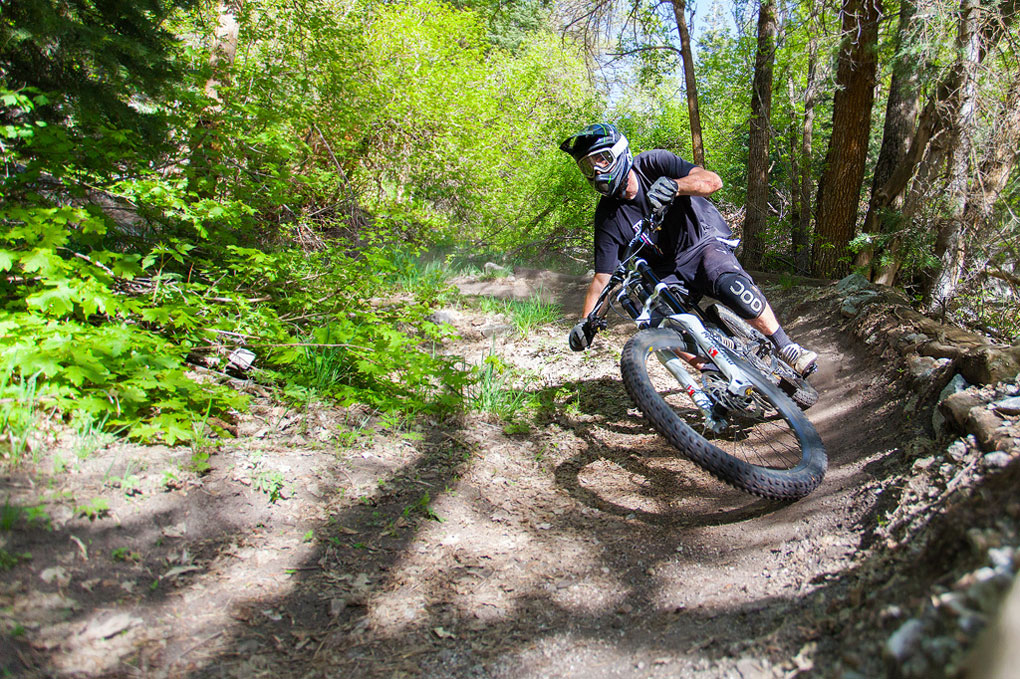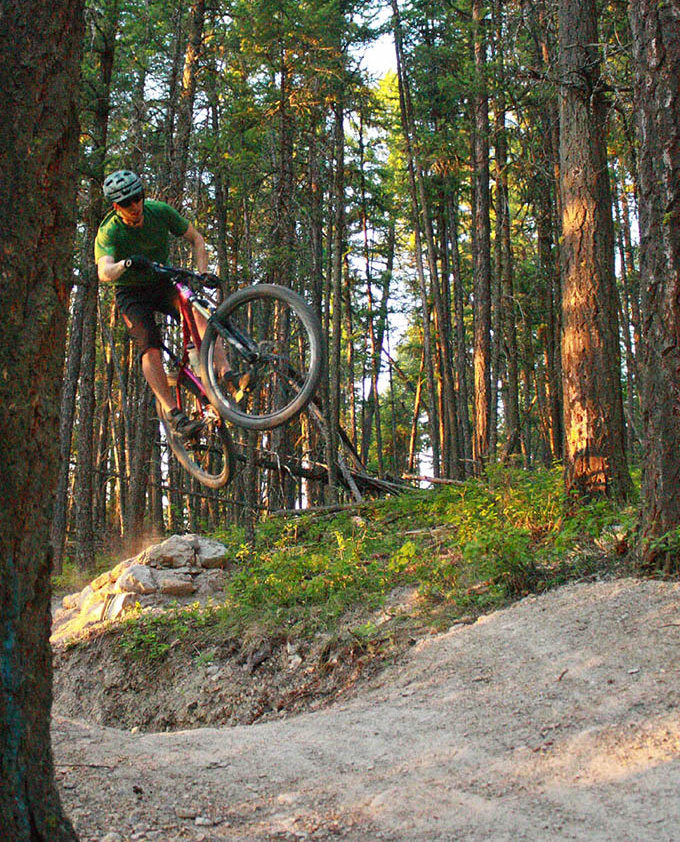Most bike companies are offering a wide assortment of bikes, but the lines between each model aren’t always clear. Bikes with different intentions, different travels, and different geometries exist in almost every manufacturer’s stable, but what’s the difference? And does it matter?
Three of our reviewers, Noah Bodman, Marshal Olson, and Tom Collier, took on the topic of short travel vs long travel trail bikes — what are they, when are they appropriate, and where do their personal preferences lie?
Q: What do you consider “short” travel? “Long” travel?
Noah: It depends a bit on the context, but for normal trail riding, I’d consider “short” travel to mean 120 mm and “long” travel to mean 160 mm.
Down around 100 mm is what I’d consider to be a bike more designed for XC racing, while 180 mm and upwards I’d call a Freeride / DH bike.
Marshal: It all depends on the trail.
Very steep and prolonged rough trail: short travel = 160 mm; long travel = 200 mm+.
Backcountry rooty and rocky trails: short travel = rigid; long travel = 140 mm
Wheel size dramatically affects travel. I am happy at 140-150 mm on 26″ wheels and 650b, and 100-120 mm on 29’ers on the same trail, though the bigger suspension and littler wheels don’t handle as well, and feel more twitchy to me at my somewhat lanky 6’2’’ build. I need a longer wheelbase, slacker geometry, and softer suspension with the little wheels to slow the handling down relative to bigger wheels.

Tom: For trail riding, I think of a short-travel bike as having somewhere around 120-140 mm of travel (this applies to forks and rear suspension). A bike with less travel than that probably ought to see time with a number plate attached and a spandex clad racer in the saddle.
A bike with 150-170 mm of travel falls squarely into the long-travel trail bike realm. Any more travel than that I think of as a DH or freeride-specific bike.
Q: How do hardtails fit into this schema?
Noah: Ummm, they don’t? Ok, around 120 mm for the fork is the sweet spot. Then, going either longer or shorter is obviously worthwhile for different situations.

Marshal: Unless the trail is super steep and technical / rough, causing the rear wheel to hang up on square edges, modern hardtails are wicked fun to ride — they certainly build skills and are very rewarding. For a hardtail, I have also settled on a 120 mm fork, but run it very stiff and set up more progressively to only use 90 mm or less of available travel. This keeps the front end up and well mated to the rigid rear end, and slows down the handling a bit.
Tom: I’d knock a bit of travel off for hardtails since they can be prone to feeling unbalanced without rear suspension to match. So I would call 100-120 mm “short” travel and 130-150 mm long travel. Plenty of people seem to like hucking off things on a hardtail with a 160 mm travel fork (or more), but I think that hardtails start diving too much in corners when they have more than 140 mm forks. (But maybe the huckers don’t turn.)
Like Noah and Marshal, I target 120-130 mm as being a balance between bump absorption and diving.

Suspension tuning and style wasn’t mentioned much. I’m not an expert tuner or anything, but even with flipping through dials and playing with air pressure, bikes, just like skis, do tend to have a certain personality of sorts. For example, lively, poppy and playful vs plush, stable and planted. For example, I found SB66s to feel more like the former (and skittish) and Nomads to feel more like the latter (and sluggish). Some of this could be geometry, but I think suspension characteristics are definitely playing a large role in the personality of the bike. I’m surprised this wasn’t mentioned by anyone. As an aside, I think shorter travel bikes are better suited towards the former, and longer travel bikes better suited towards the latter. I haven’t really looked at 275ers, mostly because they seem like a really poor allocation of my dollars with so many good 26ers going for dirt cheap (2 good bikes for the price of 1 mediocre, anyone?).
Really enjoyed this article. Great insights all around. I’m just going to need to convince the wife that I need a minimum of 3 mountain bikes. I’m sure it will go over great (haha). Lindahl, they actually have multiple articles on suspension including one that goes into a decent amount of depth on tuning your ride. Just go back to mountain biking 101 and you can find all the links there. Completely agree with your comment on the low prices of 26ers – unreal.
I’ve basically been in cryo-storage for the last decade as far as mountain bikes are concerned so this might be a question with an obvious answer but why aren’t there more long travel 29ers out there? I recently bought a Niner WFO and while I’m very happy with my purchase, there definitely isn’t the same level of selection in this category as there is in the LT 650b category. For instance, why doesn’t Santa Cruz make a 29er version of the Bronson? Is this a VHS / Beta question where one type of frame won the day “because”? Did these bikes initially come out and no one bought them? Are long travel 29ers the mono-skis of mountain biking? I’m obviously missing something. Interested in your thoughts. Thank you!
Andrew
When I first got onto a 29er this summer, my thought was that bigger wheels are to mountain biking what tip rocker is to skiing: they make the sport easier to do and therefore more accessible, more fun, etc. They’re not better than smaller wheels in every situation but in places where greasy roots and steep technical trails are common, I would imagine most riders would be happier on bigger wheels than smaller. So, when I started looking around for a new bike I was expecting to find lots of companies adopting them, across the spectrum of bike types, especially on enduro bikes. But what I found was that it’s mostly XC / trail bikes with less aggressive geometry and shorter travel (Santa Cruz Tallboy, Trek Remedy, Scott Spark, etc.) that have adopted 29″ wheels while the popular enduro (aggressive, long travel) bikes from Santa Cruz, Pivot, Devinci, Yeti, Norco, etc. are all 650b/27.5 – why is this? Maybe it’s because relatively short travel but aggressive 29ers like Evil’s The Following are facilitating the same kind of riding experience a LT 650b/27.5″ bike does (i.e. you don’t “need the extra travel because of the bigger wheels… but since when does that line of thinking apply to mountain bike manufacturers)?
Being short at 5’8″ and the lack of longer travel 29ers ruled wagon wheels out for me. I don’t buy the argument that the bigger wheel make up for 20mm of travel. Travel is travel. The real reason you don’t see long travel 29ers is that your already higher on them so longer travel would negativity impact the handling of the bike and create geometry issues. 140mm 27.5 hits the sweet spot for playful trail riding for me personally. I don’t care for flowy groomed trails so xc short travel bikes aren’t for me.
One more vote for the importance of the trails you ride:
Sure, langer travel bikeswap with slacker head angles climb very well these days.
So, out in the big mountains, you climb for 2 hours, then rip a sustained descent for 45 minutes, that’s a great set-up
On our Midwestern trails, much of the distance of a trail is spent on short rolling hills.
Having a bike that is lively pedaling out of the saddle on a short rise, having geometry that is nimble for the tight turns at slower speeds on the flats, and having firm suspension to pump every little feature, even on the uphills, makes that bike a lot more fun on these sort of trails.
So I’d argue there IS STILL a penalty for longer travel, slacker bikes.
Great article, give me more insights. Written well. We need more article like this in different subjects
Thanks
Beeson,
I am just under 6′-0″ and I feel that the 29ers with long travel are just way to Tall. I do not like to maneuver on stilts, and I would need a Medium with 29 and anything over 130 mm travel. also at some point the suspension will tweak, bind, or feel like it is hanging up as you are flicking around corners or clipping rocks.
I tend to use my dropper any time I see Technical or tight turns, and the high profile only helps for pedal strikes… not confidence in riding my outside lugs. We need a lower center of gravity without grinding down front cogs.
ah rereading ye ole comment speculation about a lack of LT 29rs… in 2024 is wild.